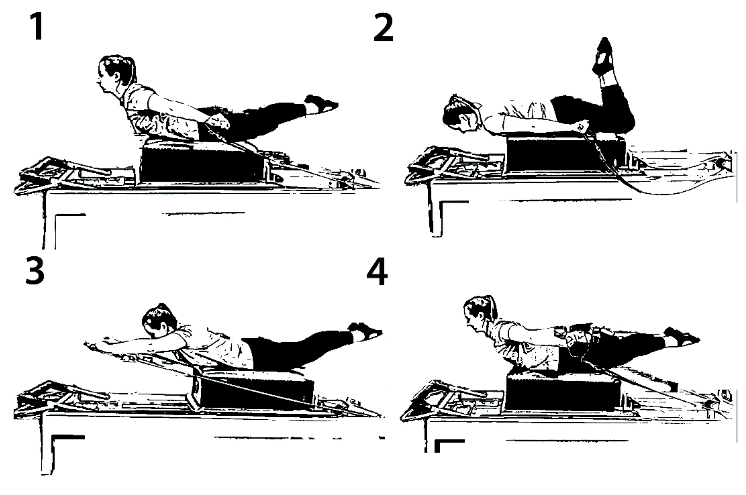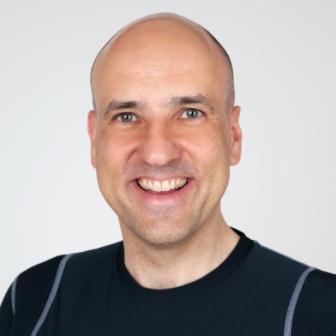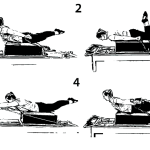Issue #301 – Wednesday May 20, 2020
Joe’s Breaststroke
by Reiner Grootenhuis
There are certain exercises in our Pilates system which seem to be difficult when you do them for the first time … and they often stay difficult even when you keep on practicing them. For many of us, one of these exercises is the Breaststroke done without a partner. This is a very different exercise that when it is done with a partner – just having a little help, with a partner matching your Powerhouse, changes many aspects of this exercise.
Now for the Breaststroke without a partner, the increase of upper chest mobility and strength, plus the gain in shoulder flexibility, provides us with a more beautiful movement experience. However, the motion of extending and pushing something upward over your head might not come naturally. Plus, the Reformer seems to fight you instead of helping you.
Consider the same exercise on the Cadillac (with a Reformer Box and some Arm Springs attached higher than your body) performed facing away from the spring attachment. What a different experience! The whole movement becomes uplifting.
Researching for my just-published Reformer Manuals (so far only available in German, English, and Korean translation in progress), I had a good look at Joseph Pilates’ Reformer pictures.
And along the way, I found some interesting things. Did you know that …
-
Joseph Pilates did not show any “Hundred” on his Reformer pictures but a similar exercise without pumping called “Stretch – Pull”?
-
What we call “Rowing – Into the Sternum” or sometimes “Rowing Back 1” was called “Rowing – Front” from him. So not “Back”.
-
Rowing – 90° Degrees or “Rowing Back 2” was for Joseph Pilates “Biceps” and “Triceps” which were two exercises for him. When were they merged?
-
Our “Rowing – From the Chest” or “Rowing Front 1” was for him “Rowing – Back”.
-
“Rowing – From the Hip” was called “Rowing – Back with bending down.”
-
The Knee Stretch – Round & Arched were his Tiger Stretch. What a lovely name. We should revitalize it.
-
The “Knees Off” was Joseph Pilates “Knee – Stretch”.
Coming back to the Breaststroke, I studied Joe’s pictures. So, let us have a look at them….
I am kidding, of course.
We all know that there might be copyright issues (or maybe not) and I just do not want to get in the middle of that. So here are some pictures I took which – except for the knee bend – are incredibly similar to Joe’s photos. One other difference is that in his pictures, the straps always have tension because his Reformer was so much shorter; mine is a Pilates Design 83″.

And there is one more difference that you might find important. In picture 3 in the original photos, Joe’s upper back is in slight flexion, and his arms are almost level with the Reformer frame. My take is that he was on the way up before going to picture 4.
Now, what is the difference to the movement as we usually do it? I like to think this version is a bit of a “Reverse Pulling Strap 1” at the beginning. The arms go from picture 2 to picture 3 down, very close to the Reformer frame. Which means you are initiating actively from the back. In this way, the work moves away from the top of the shoulders and brings it deeper. When you finally have reached your highest point, you bring your arms into a T-position and then back to the side. Again this is similar to a reverse “Pulling Straps 2” / “T-Pull.” The magic happens when you bring your arms out to the side, as the Reformer now starts to help you to get more chest extension on your way back. I have to admit that Joe’s shorter Reformer might have been even more suited for this movement, as it would have given you spring feedback all the way.
Always when I come across something new, I like to find out if others have might have known this all along. So I reached out to Deborah Lessen to see what she learned from Carola. Here is her answer:
Now I was curious how his unassisted version looked and you can find it here in the video he kindly shared.
https://vimeo.com/409310533?fbclid=IwAR3j7IYyqpQbMfT5b7CeAZbBmtsb_pD-NHzE5uKWySN7iQp7L0Qxf1nD8r4
As you might know for the last years I have been privileged and feeling so humble to being able to call Kathy Corey my mentor. And her take on the way she learned it from Ron was:
Hi Reiner, I remember doing the Breaststroke with Ron at my home studio in the early 1990’s. I don’t recall that we ever taught it at workshops. Thinking about the pattern, you started with knees bent, arms at sides of body. At the same time, you extended arms around ears and legs straight, with your head in line with your spine. Then the assistant held your legs at ankles and pressed lightly down as you lifted your torso upward creating a straight line from toes to head. The assistant pressed slightly more as you lifted higher into extension, opening your arms out to the sides of your body with palms facing outward. As the arms came around you lowered your body and the assistant released your legs. I do not remember a reverse or doing it unassisted. The photo I think was taken at the studio in Beverly Hills and I do not know who the client is.

Where does this leave us? Has someone mixed the pictures? Is what we see a reverse version of the Breaststroke? Why did Joseph Pilates did not take photos of the assisted version? If you look at Carola Trier’s Reformer photos, you will find that she took them with assistance, just as Deborah Lessen wrote.
My summary is that I have started to teach, in a group class setting, first Joseph Pilates unassisted Breaststroke (reverse) version and then later turn it around and teach the usual Breaststroke.
Feel free to experiment and let me know what you think.
Reiner Grootenhuis

Besides obtaining a diploma in psychology and an MBA, Reiner Grootenhuis has studied the healing and martial arts of the Southern Shaolin Monastery Weng Chun.
He completed the training as a Pilates instructor for Pilates mat and equipment at the Pilates educational academy Body Arts & Science International.
He is the founder and operator of the largest Pilates forum worldwide, pilates-contrology-forum on Facebook, which includes 9200 Pilates instructors. He also offers a free of charge hugly successful pilates-contrology-marketplace for selling and buying Pilates equipment on Facebook which has almost 8300 members.
At the beginning of 2012, he opened the pilates-powers studio only 25 km away from Joseph Pilates hometown.
2014 Kathy Corey appointed him a member of the Board of Directors of the Pilates Heritage Congress, which takes place every two years in the hometown of Joseph Pilates.
In 2015, he published the first publicly available German training manual on the Wunda Chair and 2016 an Baby/Arm Chair manual.
In 2017, Reiner completed the Kathy Corey Mentor program, in which he learned the methods and exercises of teachers trained directly by Joseph Pilates such as Kathy Grant, Ron Fletcher, Eve Gentry, Bruce King and Romana Kryzanowska.
2018 Reiner published the first publicly available German Pilates Cadillac manual.
Since November 2017 Reiner has been a Pilates Intel Expert for the online magazine Pilates Intel for which he writes regularly.
Since September 2018 Reiner has been nominated as a member of the Certification Committee of the German Pilates Association.

